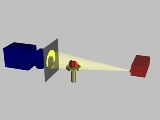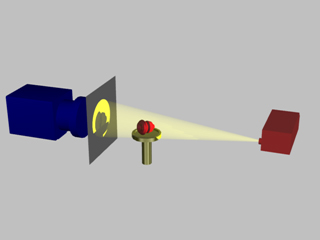
Cone beam reconstruction
Encyclopedia
For microtomography
, X-ray scanners typically use two methods for scanning:
 Cone beam reconstruction uses a 2-dimensional approach for obtaining projection data. Instead of utilizing a single row of detectors, as fan beam methods do, a cone beam systems uses a standard charge-coupled device
Cone beam reconstruction uses a 2-dimensional approach for obtaining projection data. Instead of utilizing a single row of detectors, as fan beam methods do, a cone beam systems uses a standard charge-coupled device
camera, focused on a scintillator
material. The scintillator converts X-ray radiation to visible light, which is picked up by the camera and recorded. The method has enjoyed widespread implementation in microtomography
, and is also used in several larger-scale systems.
An X-ray source is positioned across from the detector, with the object being scanned in between. (This is essentially the same setup used for an ordinary X-ray fluoroscope).
Projections from different angles are obtained in one of two ways. In one method, the object being scanned is rotated. This has the advantage of simplicity in implementation; a rotating stage results in little complexity. The second method involves rotating the X-ray source and camera around the object, as is done in ordinary CT scanning and SPECT imaging. This adds complexity, size and cost to the system, but removes the need to rotate the object.
 The method is referred to as cone-beam reconstruction because the X-rays are emitted from the source as a cone-shaped beam. In other words, it begins as a tight beam at the source, and expands as it moves away.
The method is referred to as cone-beam reconstruction because the X-rays are emitted from the source as a cone-shaped beam. In other words, it begins as a tight beam at the source, and expands as it moves away.
Microtomography
Microtomography , like tomography, uses x-rays to create cross-sections of a 3D-object that later can be used to recreate a virtual model without destroying the original model....
, X-ray scanners typically use two methods for scanning:
- Fan beam reconstruction
- Cone beam reconstruction.

Charge-coupled device
A charge-coupled device is a device for the movement of electrical charge, usually from within the device to an area where the charge can be manipulated, for example conversion into a digital value. This is achieved by "shifting" the signals between stages within the device one at a time...
camera, focused on a scintillator
Scintillator
A scintillator is a special material, which exhibits scintillation—the property of luminescence when excited by ionizing radiation. Luminescent materials, when struck by an incoming particle, absorb its energy and scintillate, i.e., reemit the absorbed energy in the form of light...
material. The scintillator converts X-ray radiation to visible light, which is picked up by the camera and recorded. The method has enjoyed widespread implementation in microtomography
Microtomography
Microtomography , like tomography, uses x-rays to create cross-sections of a 3D-object that later can be used to recreate a virtual model without destroying the original model....
, and is also used in several larger-scale systems.
An X-ray source is positioned across from the detector, with the object being scanned in between. (This is essentially the same setup used for an ordinary X-ray fluoroscope).
Projections from different angles are obtained in one of two ways. In one method, the object being scanned is rotated. This has the advantage of simplicity in implementation; a rotating stage results in little complexity. The second method involves rotating the X-ray source and camera around the object, as is done in ordinary CT scanning and SPECT imaging. This adds complexity, size and cost to the system, but removes the need to rotate the object.


